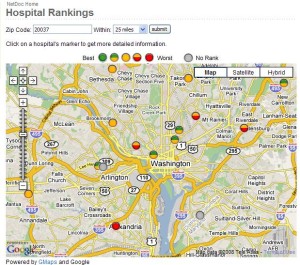An earlier article on this blog talked about physician rankings. In this post let’s look at hospital rankings.
America’s best hospitals
There are various agencies and organizations that rank, index and grade american hospitals. Some of the well know ones are US News, Thomson Healthcare (top 100) and more recenlty web 2.0 sites like HealthGrades. The idea behind these rankings is to provide consumers a guide map to choosing hospitals.
Methodology
Methodology that these publications and agencies use range from internally developed surveys to benchmarking databases and others use information that is collected and published by United States Department of Health and Human Services. US news ranks by specialty as their goal is to identify facilities that excel at treating variety of illnesses within a specialty, as opposed to just few procedures. US News uses data from the American Hospital Association survey of its members.
Web 2.0 application – Finding a hospital near you
Recently we came across a web based application that lets you search for hospitals in your neighborhood (by zip code) and tells you how good the hospitals perform on a variety of process measures that the hospital compare database (Department of Health and Human services)tracks. The best hospitals have green stop lights and the worst has red. We tried this on Washington DC area hospitals and here is what we came up with. Check it out for yourself.
